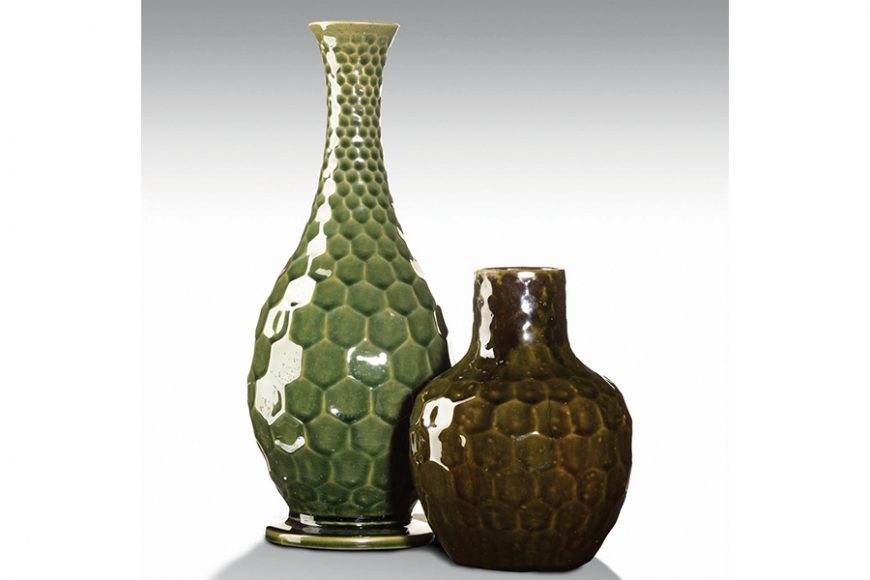There is growing interest in collecting 20th- and 21st-century ceramics, and many contemporary art galleries count a ceramic artist in their stables. So it seems time to look back at the movement’s origins. The term “art pottery” in the United States was first applied in the 1870s to Chelsea Keramic Art Works. That Massachusetts-based firm, and its later iterations as Chelsea Pottery and Dedham Pottery, offered a roller coaster ride of artistic and commercial triumph and failure. Running through it all was the obsessive drive of one man, Hugh C. Robertson.
The Roberston clan, including father James and his four sons, were trained potters who immigrated to the United States in the 1850s. By the 1870s, they had settled in Chelsea where their pottery works came to represent a diverse selection of utilitarian and decorative ceramics. At first, the firm drew heavily on ancient Greek, Japanese and English reform styles and they employed a number of talented sculptors and decorators.
Of the four sons, it was Hugh (1845-1908) who had an unyielding desire to experiment with clays and glazes. As a result, he propelled the firm to both its greatest glories and its most dire circumstances. Robertson initially focused on Asian ceramic forms and glazes. In Boston, he had access to a number of Asian ceramic collections that served as inspiration. He would also have encountered the extensive Chinese and Japanese ceramic displays at the Philadelphia Centennial exhibition in 1876, where he demonstrated pottery throwing. Robertson first experimented with and mastered the shiny and matte glazes of Chinese monochrome wares, concentrating on the blue, green and yellow hues popularized by the Aesthetic Movement.
Robertson then focused on Chinese sang-de boeuf or oxblood glaze, seeking to recreate the color of fresh arterial blood. He was not was not alone in his quest to master the notoriously difficult and costly technique, but in 1885 he was the first in the United States to do so. The technique required precise control of glaze, body, and kiln temperature. With pride, Robertson referred to his creations as Dragon’s Blood, Sang de Chelsea and Robertson’s Blood. Between 1885 and 1887, Robertson created some 300 oxblood works of varied hues with surfaces ranging from smooth to orange peel.
Other successes during this highly experimental period included a Chinese peach bloom glaze that transitioned from red to apple green tones and a crackled white glaze that featured a fine network of cracks. Robertson’s relentless experimentation was costly, and he failed to find buyers for his works, which he had priced aggressively. Facing financial ruin, the Chelsea Keramic Art Works was forced to close in 1889.
In 1891, with new financial backers, Robertson reopened the Chelsea Pottery, renamed Dedham pottery in 1896, apparently on the condition that Robertson was forbidden to experiment with sang-de-boeuf glazes. The new firm achieved financial success, employing Robertson’s crackled white glaze on tablewares with decorative borders. The blue-bordered “Dedham rabbit,” so commonly associated with the pottery, was reworked to encompass more than 50 different animal and floral borders, ensuring the firm’s survival.
With the commercial success of Dedham blue and white crackleware, Robertson continued to experiment with crackled, colored and textured glazes, including the forbidden sang-de-bouef. He rubbed his crackled white pieces with carbon black to accentuate the crazed network and then embellished them with splashes of color or cobalt decoration. He layered his colored glazes one upon the other to create startling color combinations and painterly effects. His textured glazes with bubbled surfaces, dubbed “lava like,” resembled a volcanic or lunar landscape. By allowing the glazes to mingle and drip, Robertson’s resulting creations were accidental and abstract in nature.
Robertson’s glazed works were too radical for most of his contemporary critics and collectors. Financial success eluded him with these pieces, but he did attain a measure of critical recognition with awards at the 1900 Paris and 1904 Louisiana Purchase exhibitions. When Roberson died of work-related lead poisoning in 1908, Dedham’s art pottery came to an end. The firm continued to produce the Dedham tableware until it was shuttered during World War II. In 1943, the firm’s collection of 19th- and 20th-century works was liquidated at Gimbels department store in Manhattan.
David Rago, an expert on American pottery, notes that Robertson’s work was finally acknowledged and became highly collectible in the 1970s and ’80s. An impressive collection of Robertson’s work is found at The Metropolitan Museum. (It was recently gifted by the collector Robert A. Ellison.) The holdings of the Museum of Fine Arts, Boston include the “Twin Stars of Chelsea” — Robertson’s prized oxblood vases.
Today a great example of Robertson’s sang-de-boeuf, volcanic, or iridescent glaze can bring $10,000 at auction, while many fine pieces top out under $5,000. Robertson lags behind his contemporary, George Ohr, the “mad potter of Biloxi,” (February WAG), whose work continues to grow in value. According to Rago, the essential difference between the two is that while Robertson is seen as a potter, Ohr is known as an artist who just happened to select pottery as his medium.
For further reading, see Alice Cooney Frelinghuysen’s “American Art Pottery: The Robert A. Ellison Jr. Collection” (2018).
Jennifer Pitman writes about the decorative arts, jewelry and fine art she encounters as Rago Auctions’ senior account manager for Westchester and Connecticut. For more, contact jenny@ragoarts.com or (917) 745 2730.


